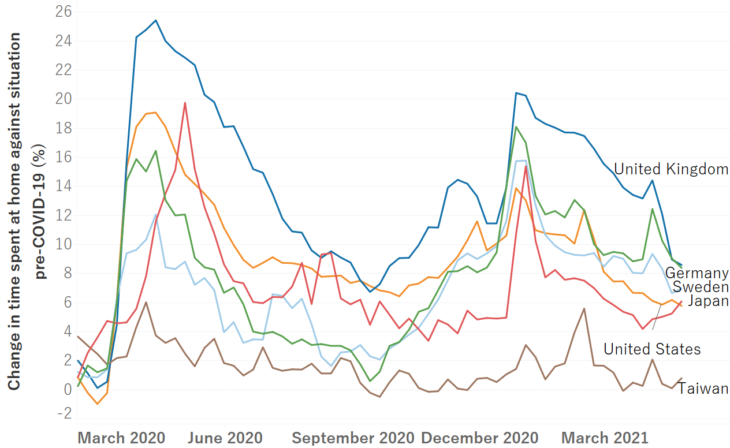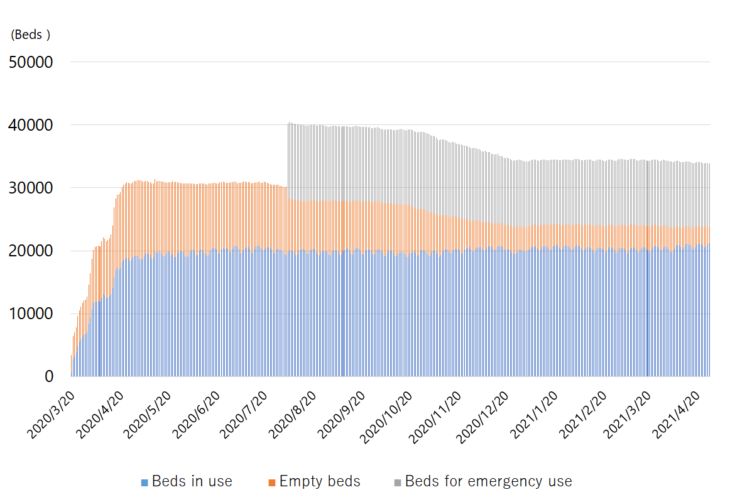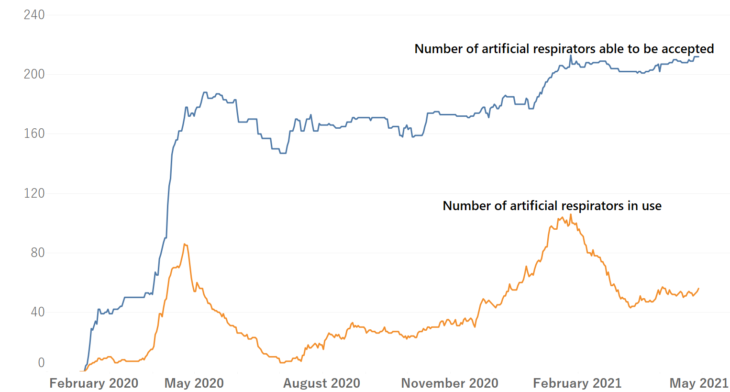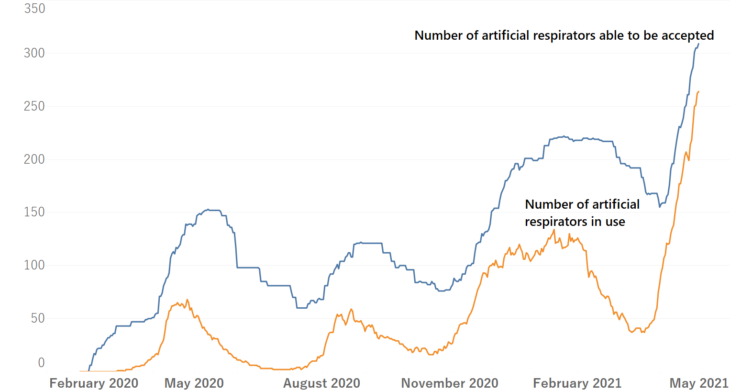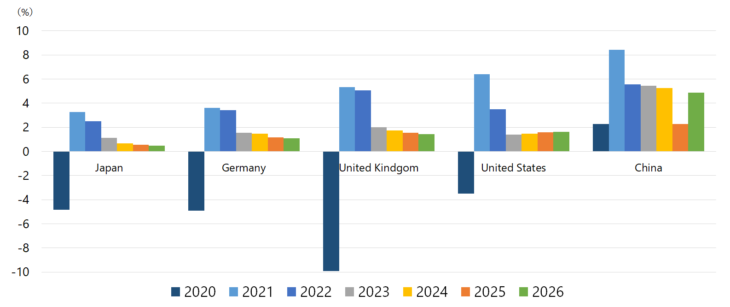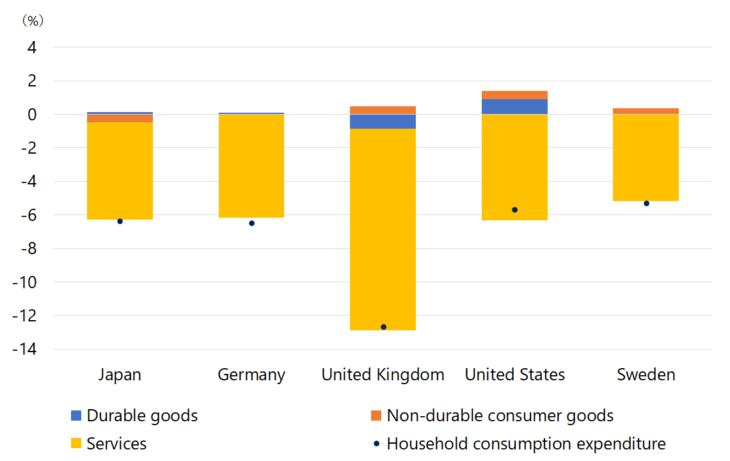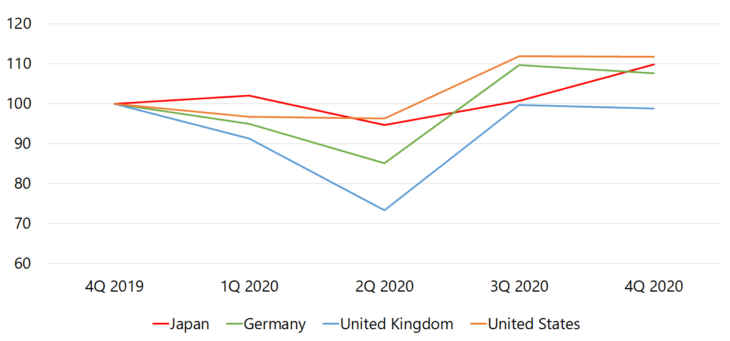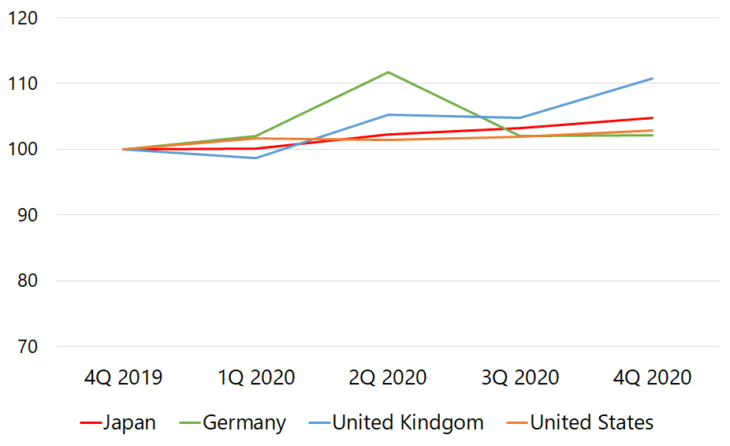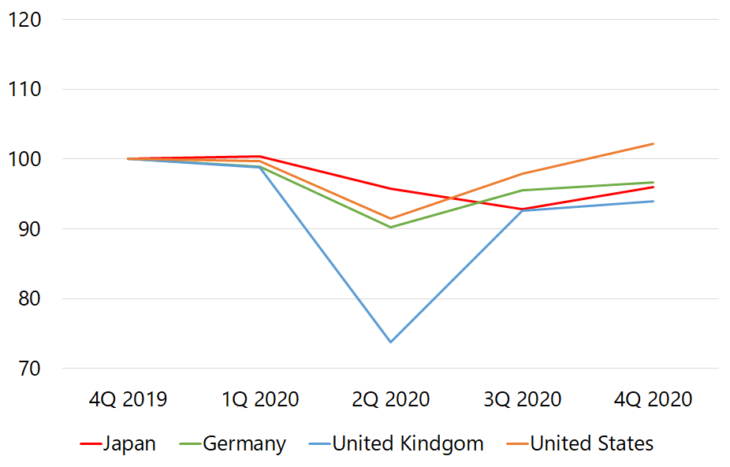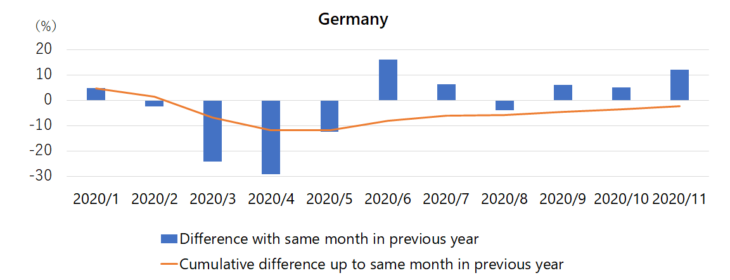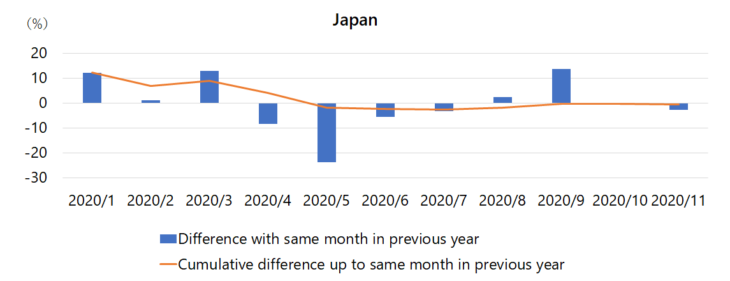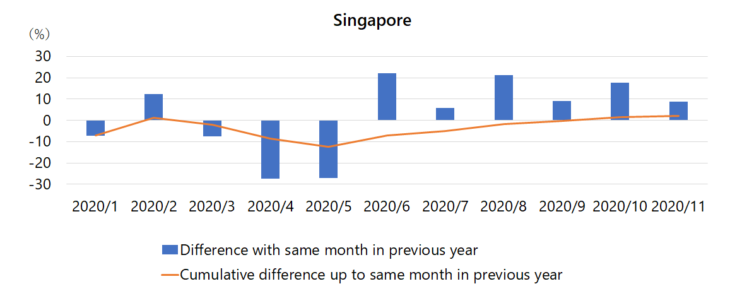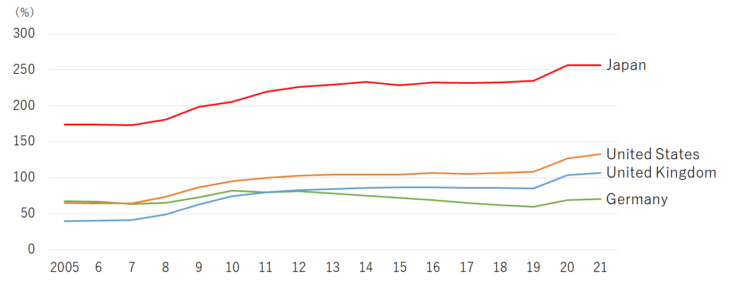Characteristics and Issues of Japan’s Response to COVID-19 — An International Comparison —
Okina Yuri, Executive Vice President, Nippon Institute for Research Advancement (NIRA),
Chairperson, The Japan Research Institute, Limited
Abstract
In 2020, the world economy was struck by the unprecedented crisis of the COVID-19 pandemic. Japan’s response to the pandemic has been comparatively successful when considered from an international perspective, and has reduced the nation’s mortality rate. At the same time, it must be said that it has also highlighted serious structural issues in Japanese society.
Based on an international comparison, the most important issues to be addressed can be seen to include comprehensive review of the system of medical care and the cultivation of readiness for emergency responses. In addition, the important issues from the perspective of ensuring economic security are the enhancement of vaccine development, flexible responses with regard to the various regulations associated with vaccination, and focused and flexible government expenditure with clear priorities based on data analysis and a vision for the future of Japanese society.
Moreover, responses to the expansion of public debt and widening economic disparities due to COVID-19 will be important policy measures for the future. With regard to these issues, it will be necessary to review factors including the tax system and the direction for procurement of government finances from the perspective of reducing disparities.
The Importance of Viewing Japan from an International Perspective*

Dr. Okina Yuri
In 2020, the world economy was struck by the unprecedented crisis of the COVID-19 pandemic. How does Japan’s response compare to the rest of the world? In this paper, I will conduct an international comparative analysis of the responses to COVID-19 mounted in 2020 by Japan and developed nations throughout the world using a variety of data, and discuss the policy issues that we must consider at this moment, when there is still no sign of a resolution of the pandemic situation. Japan’s response to the pandemic has been comparatively successful when considered from an international perspective, and has reduced the nation’s mortality rate. At the same time, it must be said that it has also highlighted serious structural issues in Japanese society. Based on an international comparison, the most important issues to be addressed can be seen to include comprehensive review of the system of medical care and the cultivation of readiness for emergency responses. In addition, the important issues from the perspective of ensuring economic security are the enhancement of vaccine development, flexible responses with regard to the various regulations associated with vaccination, and focused and flexible government expenditure with clear priorities based on data analysis and a vision for the future of Japanese society.
Moreover, responses to the expansion of public debt and widening economic disparities due to COVID-19 will be important policy measures for the future. With regard to these issues, it will be necessary to review factors including the tax system and the means of procuring government finances with a focus on reducing disparities, the best type of social safety net, and the relationship of these with monetary policy.
1. The COVID-19 Pandemic and National Economies
More than a year has passed since the outbreak of COVID-19. Vaccination has progressed in some developed nations, but the virus continues to spread, and we have not yet reached the stage of resolution of the pandemic situation. Up to the present, in NIRA Opinion Papers No. 52 and 54, we have looked at the responses to COVID-19 in Sweden and Germany, nations which are deploying distinctive policies[i]. Since then, the situation has diverged significantly among different nations, with some facing severe difficulties as a result of the pandemic, and others moving towards a resolution of the situation. What is Japan’s current status, and what specific stance towards the issues has the nation adopted? Based on international comparison with other developed nations, in this paper I will delineate the characteristics and issues of Japan’s COVID-19 response for approximately one year in Japan, using data including GDP data up to the fourth quarter of 2020 (October-December; termed 4Q) for each nation as a guide, and attempt an evaluation on this basis.
(1) Relationship Between Mortality Rate and Economic Damage
Figure 1: International trends in mortality rates
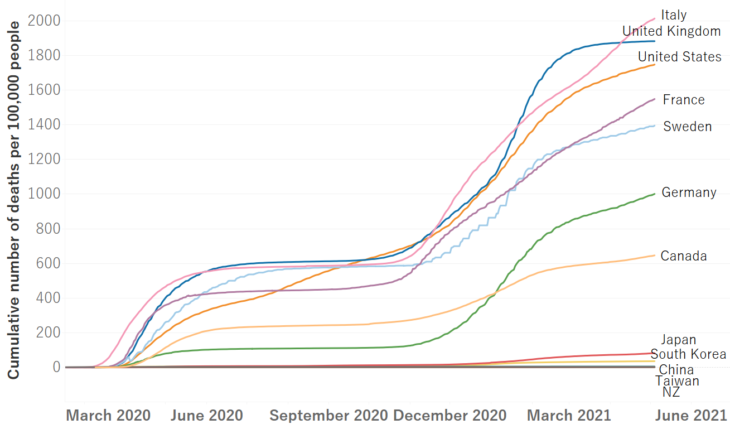
Source: Formulated by NIRA based on data from the COVID-19 Data Repository by the Center for Systems Science and Engineering (CSSE) at Johns Hopkins University
COVID-19 affects economies in terms of both supply and demand. First, when emergency COVID-19 responses such as lockdown or the declaration of a state of emergency were put into effect, intercity movement for purposes such as tourism and eating out and other social activities were directly suppressed, and the demand for related services that require face-to-face contact was itself reduced. This sharp decline in service consumption is an overwhelmingly significant factor in the economic damage suffered by major nations. In addition, there is a psychological aspect; it is quite possible that factors including population decline due to an increase in deaths, decline in income due to the deterioration of the employment situation (for example, in the area of service-related employment), vigilance with regard to infection, increased anxiety and the worsening of the economic outlook, may result in a decline in household consumption and corporate investment, among other factors. On the supply side, on the other hand, productivity may be reduced due to the suspension of operations at certain factories and the implementation of measures against COVID-19 in the workplace. Based on this perspective, I would like to consider the relationship between Japan’s response to COVID-19 and economic recovery in the nation, while also looking at benchmark indicators.
First, looking at the number of COVID-19 cases and deaths per capita, figures for Japan are vastly lower than figures for Western nations. In particular, Japan’s mortality rate (the ratio of the number of deaths to population) is low, and this may be seen as a result of the nation’s measures to control the spread of the virus. The data allow us to confirm that the mortality rates of Western nations such as the United Kingdom, Italy and the United States are high, and those of Asian nations are low (Figure 1).
Figure 2: Comparison of the number of deaths exceeding the average for the past five years in each nation considered
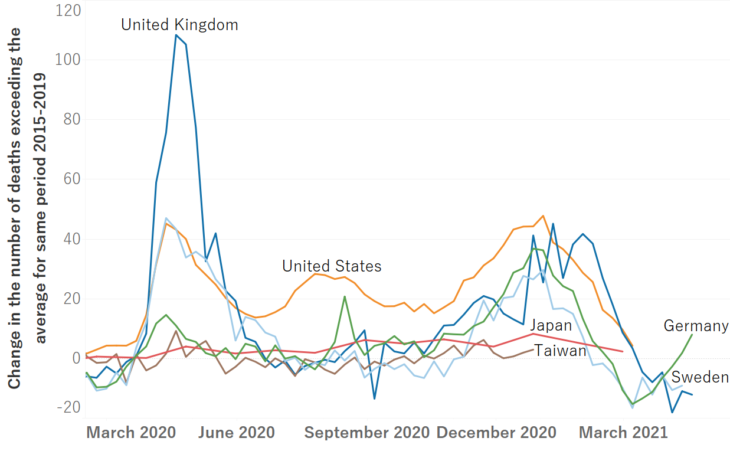
Note: Shows the difference from average mortality figures for the period from 2015 to 2019.
Source: Formulated by NIRA based on “Excess mortality P-scores” as calculated by Charlie Giattino, et al, from The Human Mortality Database, The World Mortality Dataset.
Giving consideration to the extent to which the total number of deaths exceeds the number prior to the pandemic, termed the “excess mortality rate,” the impact of the pandemic in relation to the total populations of Japan and Taiwan is consistently low, despite the limitation represented by the unavailability of data in recent months (Figure 2). In April 2020, the number of deaths in the United Kingdom exceeded 100% compared to the previous year, and the number of deaths in the United States and Sweden was also high in 2020. In the case of Japan, the number of excess deaths increased by about 8% compared to the previous year at the end of 2020, but overall, the number of deaths due to other diseases such as influenza decreased due to thorough compliance in masking and hand washing. The major trend can therefore be indicated as a number of deaths about the same as the average year, with no particular effect as a result of the pandemic in terms of the total population.
Is the number of deaths caused by COVID-19 affecting economies? Looking at a possible negative correlation between the COVID-19 mortality rate and the rate of change in nominal GDP up to the 4th quarter of 2020 for IMF member nations, we find a figure of -0.22. It therefore cannot be concluded that there is an explicit correlation (Figure 3). Italy and Spain have high mortality rates, and the economic downturn in these nations is also significant, which suggests a negative correlation. However, despite the fact that their mortality rates are also high, the economic downturns in nations such as the United States and Sweden have been low by comparison. Overall, Asian countries display lower mortality rates than Europe and the United States, and the level of damage to Asian economies has tended to be low. This is also true for Japan; Taiwan and South Korea have lower mortality rates, and have curbed any economic downturn.
Figure 3: Economic downturn in IMF member nations
(year-on-year comparison of nominal GDP in 4Q, 2020) and mortality rate (4Q)
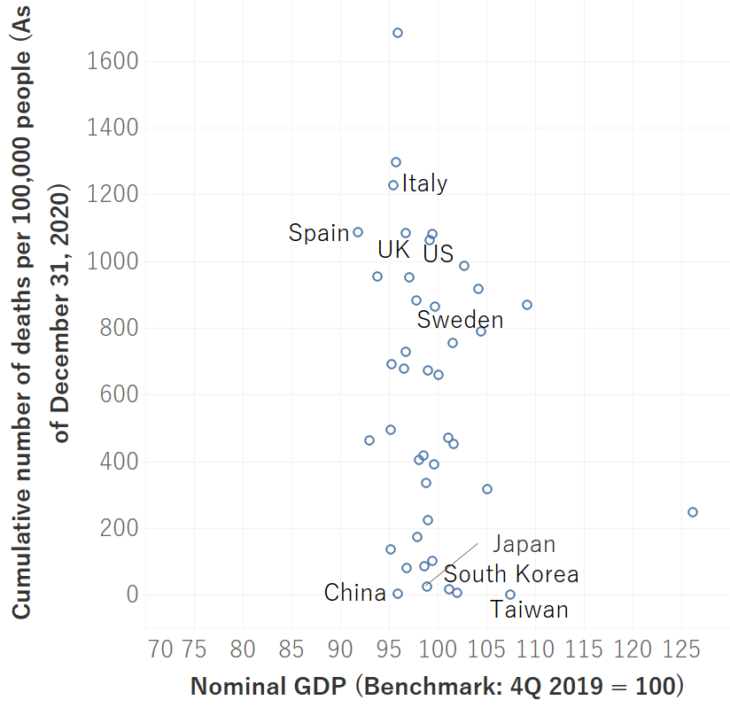
Note: Nominal GDP data is employed due to the fact that real 4Q GDP figures cannot be obtained for numerous IMF member nations. n = 42.
Source: Formulated by NIRA based on IMF “International Financial Statistics” and the COVID-19 Data Repository by the Center for Systems Science and Engineering (CSSE) at Johns Hopkins University.
(2) Impact on Economies Due to Decline in Consumption of Services
1) International Comparison of Economic Damage
Global economic growth fell sharply in the first quarter of 2020 (1Q) due to the spread of COVID-19. Following this, the world economy began to recover, but the infection spread again in the winter, causing a deadlock in recovery. In 2021, efforts towards vaccination are accelerating throughout the world, and it is expected that economic recovery will proceed successively from the countries that have vaccinated first.
In comparing GDP in each country, because methods of estimation of deflators, etc. are not unified, both real and nominal GDP data were employed. In addition, in order to evaluate the degree to which GDP has returned to pre-COVID levels, the average period of recovery from the second quarter (2Q) to the fourth quarter (4Q) of 2020 (excepting the severely affected first quarter of 2020), was compared with the fourth quarter of 2019 (4Q) (Figure 4).
Figure 4: Rate of increase and decrease in 2Q – 4Q 2020 actual and nominal GDP compared to 4Q 2019 by demand component
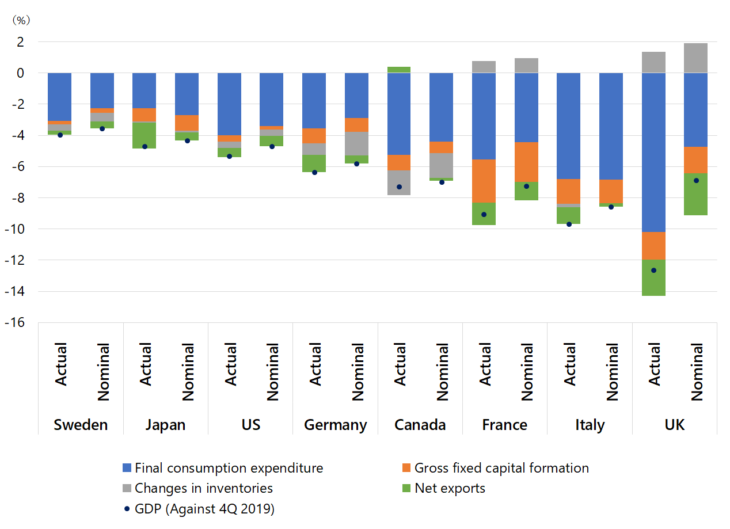
Source: Formulated by NIRA based on Cabinet Office, “National Accounts: Quarterly Estimates of GDP for Oct.-Dec. 2020 (The Second preliminary Estimates),” Statistics Sweden, “GDP Quarterly 1993–2020: 4,” UK Office for National Statistics “Quarter 4 (Oct to Dec) 2020, quarterly national accounts.
First, looking at trends in the economies of the developed nations (G7 nations and Sweden), it can be seen that decline in consumption accounts for the greater part – 70% to 80% – of the total decline in GDP. Considering individual nations, the UK, Italy, and France displayed the most significant declines. The UK’s final consumption expenditure shows the status of decline in nominal rather than actual terms, due to the fact that the government’s method of estimating the medical and educational deflators for final consumption expenditure is different from those of the other nations considered[ii].
The figures show that the decline in Japan is minor among the developed nations, and Japan’s economic damage is the second lowest after Sweden, which did not impose a lockdown.
2) Economic Impact of Time Spent at Home
It has been said that Japan’s policy response to the pandemic was more relaxed than those of other developed nations, and the stringency index for Japan’s policy measures is in fact low (Figure 5-①), and the time spent by Japanese people at home was also short (Figure 5-②). A scatter plot of the stringency index and time spent at home for the 125 nations for which data could be collected showed a fairly low positive correlation of 0.52, suggesting that policy coercion tended to lengthen the amount of time spent at home (Figure 5-③).
Figure 5: Stringency index for policy measures, degree to which people stayed at home, and their correlation for each nation considered
① Stringency index
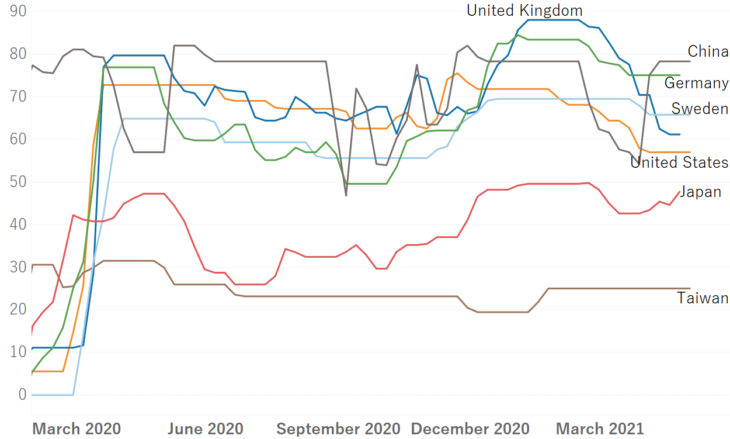
Source: Formulated by NIRA based on Thomas Hale, et al (2021), “A global panel database of pandemic policies (Oxford COVID-19 Government Response Tracker).”
② Degree to which people stayed at home
③ Correlation between time spent at home and stringency of policy measures
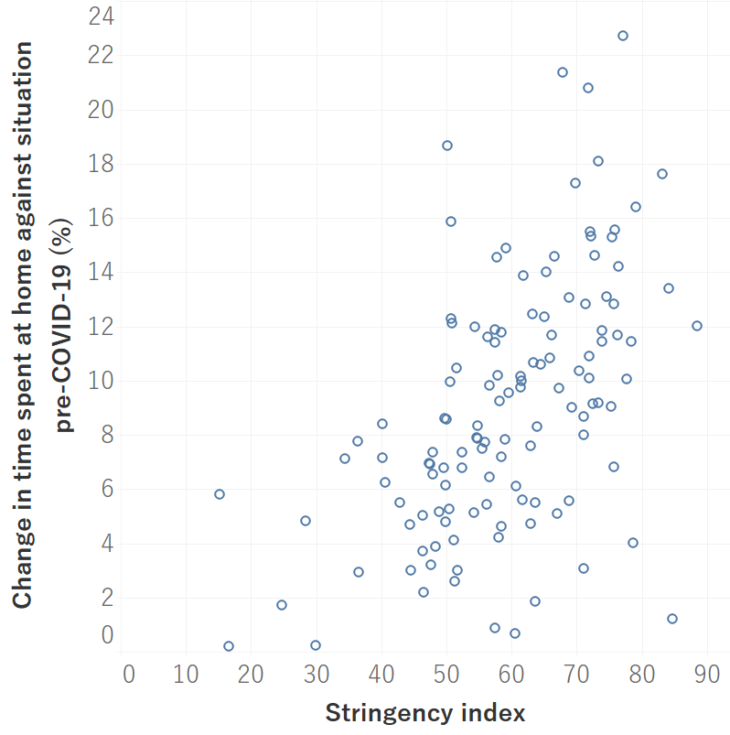
Source: Formulated by NIRA based on Thomas Hale, et al (2021), “A global panel database of pandemic policies (Oxford COVID-19 Government Response Tracker)” and Google LLC, “Google COVID-19 Community Mobility Reports.”
There is a negative correlation of -0.79 between the time spent at home in advanced nations and the rate of change in real GDP (average for 2020) (Figure 6). The leniency of the restrictions imposed by the national government and local governments in Japan suggest the possibility that the degree of change in people’s behavior has been minimal, and that direct suppression of economic activity may have been lower than in other countries. The economic downturn has also been small in Sweden, which did not impose a lockdown.
Taiwan has had a lower stringency index than Japan for almost an entire year, and the time spent at home there is almost the same as it was before the pandemic. As a result, Taiwan’s economic downturn has been minor. As we can see, this international comparison suggests that if government-mandated measures are relatively lenient, time spent at home will be short, or, even if there are restraints on behavior, if these last only for a short period of time, the impact on areas such as tourism, eating and drinking, and transportation, which are based on face-to-face service consumption, may be small. Digitalization is progressing in developed nations, and it is possible that employment can be maintained at home by digital means and the consumption of everyday items can be maintained through e-commerce. However, in Britain, where the ratio of face-to-face services in consumption is high, the fact that stringent lockdown measures have been applied for an extended period suggests the possibility that they may have significantly damaged the nation’s economy.
Figure 6: Time spent at home and GDP growth rate
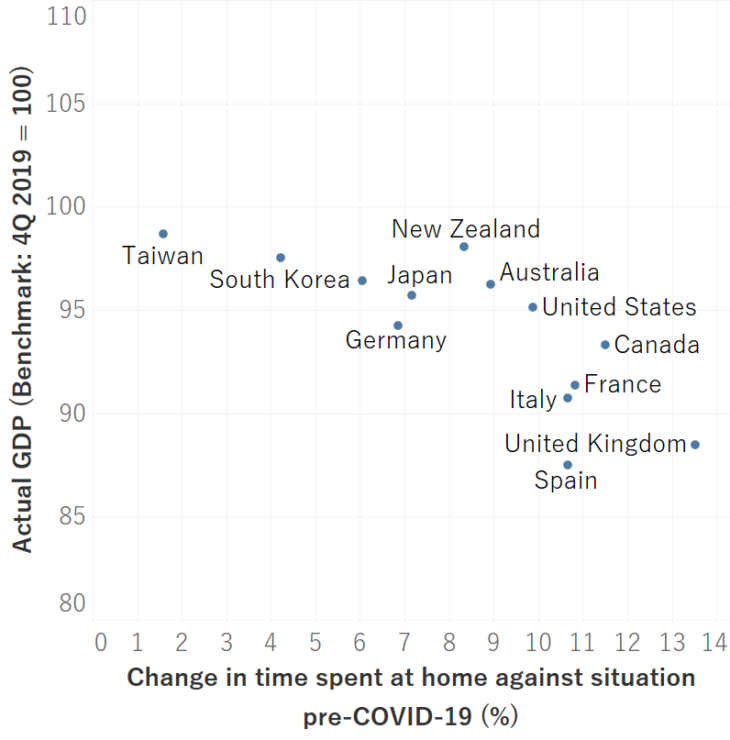
Source: Formulated by NIRA based on and Google LLC, “Google COVID-19 Community Mobility Reports,” Cabinet Office, “National Accounts: Quarterly Estimates of GDP for Oct.-Dec. 2020 (The Second preliminary Estimates),” and OECD, “Quarterly National Accounts.”
(3) Medical Care System and Economic Recovery
The major issue that can be pointed to in Japan’s system of medical care is the fact that its ability to accept severely ill patients is lower than that of the medical care systems in Western nations. While the number of patients either infected with or severely ill with COVID-19 is low, there is a lack of ICUs able to provide critically ill patients with ventilators and extracorporeal membrane oxygenation (ECMO), and the system will soon be under pressure. This problem may prolong the economic stagnation associated with the COVID-19 crisis and delay future economic recovery. In addition, the fact that delays in vaccination are becoming conspicuous in comparison to other developed nations is a major cause for concern in relation to future economic recovery.
1) Increase in Number of Severely Ill Patients and Trends in Mortality Rates
As mentioned above, Japan has a low number of deaths from COVID-19. However, looking at the case fatality rate, calculated by dividing the number of deaths due to the virus by the number of infected people, we find that while the rate was previously low compared to other countries, it has more recently leveled off following a slight increase, and since March 2021, the figure has been basically equivalent to that of the U.S. (Figure 7). It is possible that lying behind this slight increase in the ratio of deaths to the number of infected people in Japan is, in addition to the fact that there are numerous cases among elderly people who are prone to serious illness, that the medical care system is prone to come under pressure as the number of severely ill people increases.
Figure 7: Ratio of number of deaths to number of COVID-19 cases in advanced nations (Case fatality rate)
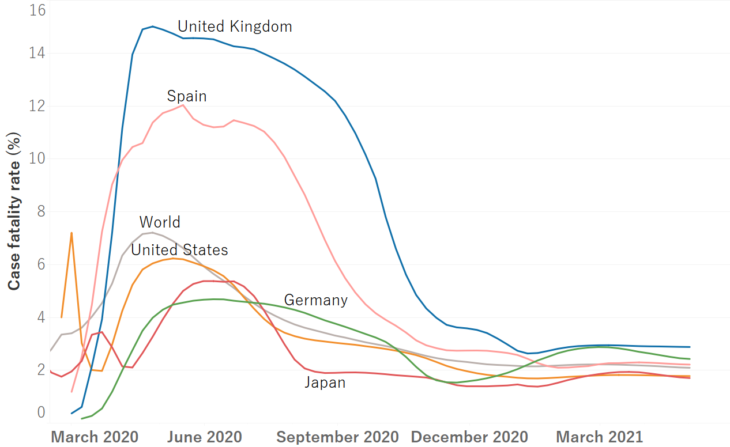
Source: Formulated by NIRA based on the COVID-19 Data Repository by the Center for Systems Science and Engineering (CSSE) at Johns Hopkins University.
Looking at changes in the number of severely ill patients in Japan, in January at the height of the third wave, the number of the severely ill exceeded 1,000. Following this, the number gradually decreased, but before returning to its level prior to the third wave, the fourth wave arrived and the number rapidly exceeded the previous level (Figure 8). On the other hand, the number of deaths has changed in tandem with the trend in the number of severely ill people, and has begun to increase again since the beginning of April. Here, I will venture to look at the trend in the ratio of the number of deaths divided by the number of the seriously ill. It can be seen that during the third wave, the proportion of fatalities among the severely ill increased. Until then, it had been in the range of 2-8%, but during the third wave, it increased to a level of 14-16% all at once. We cannot determine the reason for this, but it is possible that the pressure on the medical system had some effect. A delay in the provision of appropriate treatment increases the risk of death. In order to minimize the number of victims of COVID-19, we must control the increase in the number of the severely ill, thus avoiding pressure on the medical system.
Figure 8: Number of deaths and severely ill patients due to COVID-19 in Japan, and ratio between them
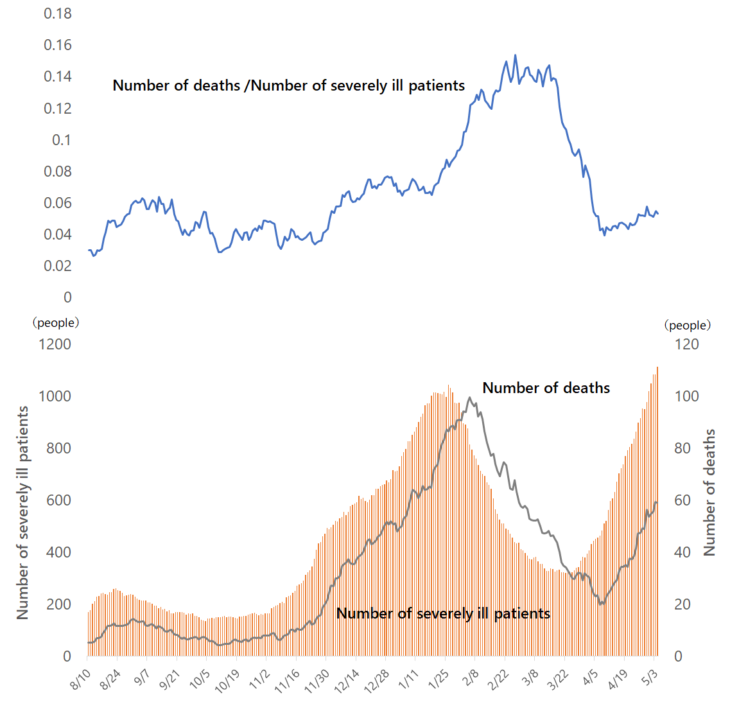
Note: The number of deaths is a moving average for 7 days.
Source: Formulated by NIRA based on the Ministry of Health, Labor and Welfare website “Status of Domestic Outbreaks, etc.”
2) Examination of the Causes of Pressure on the Medical System … Essential Number of ICUs for Base-Level Functioning of Medical Care System, Flexible Bed Conversion, Securing Doctors, Inter-Regional Cooperation, Inter-Hospital Cooperation, IT Implementation
A variety of factors can be considered as possible reasons for the potential pressure on the medical system in Japan.
To begin, there is the problem of the level of establishment of ICUs in the first place. In Germany and the United States, the number of ICU beds accounts for a significant percentage of all beds (OECD statistics show figures of 8% for Germany and 7% for the United States). Because the figure for Japan is only 2%, it is expected that if the number of seriously ill patients increases, there will be immediate pressure on the system. In Japan, the number of beds per 1,000 people is high at 13.0, but the number of ICU beds is overwhelmingly low at 5.2 beds per 100,000 people (Figure 9).
Figure 9: Number of beds and ICU beds in each nation considered
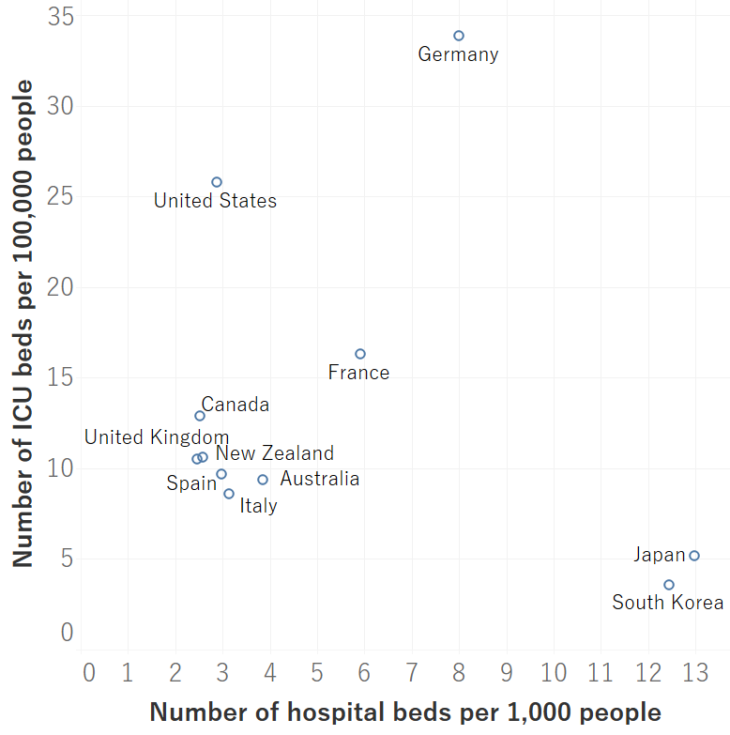
Source: Formulated by NIRA based on OECD (2020), “Beyond Containment: Health systems responses to COVID-19 in the OECD” and “Health at a Glance (2019).”
With regard to international comparison of the number of ICU beds, it has been pointed out that figures for Japan are underestimated due to differences in definition with other countries. However, the number of ICU beds per 100,000 people in Japan is about 13.5 beds according to data calculated by the Ministry of Health, Labor and Welfare, even if ICU and high care units for patients of an intermediate severity level are included. This is less than half of Germany’s 29.2 beds[iii].
As of the end of April, Germany had more than 30,000 ICU beds for a population of 84 million, and there are still about 10,000 vacant spaces (Figure 10). The number of ICU beds in Germany indicated here does not represent beds devoted exclusively to the treatment of COVID-19, but the total number of ICU beds in the country. It is said that a quarter of these will be allocated for COVID-19 treatment; if the figure is converted for a population the size of Tokyo’s (14 million), it would represent about 1,250 ICU beds dedicated to COVID-19 treatment. This is an order of magnitude higher than the number of beds in Tokyo. However, the number of ICUs in Germany includes beds for relatively mild oxygen inhalation, which makes a strict comparison with Japan difficult.
Figure 10: Number of ICU beds in Germany
The second set of factors related to ICUs are flexible bed conversion, inter-regional cooperation, inter-hospital cooperation, and flexible allocation of doctors. The status of COVID-19 infections varies significantly from region to region. It is therefore essential to ensure the readiness of medical systems at both national and regional levels. Looking at changes in the number of artificial respirators that can be accepted and the status of use of artificial respirators in Tokyo and Osaka based on data available from the ECMOnet site, it can be seen that the situation differs completely depending on the region (Figure 11-①, ②). The situation in Osaka Prefecture as of early May was extremely serious, and there was no leeway with regard to ICUs able to conduct treatment using artificial respirators. Since mid-April, the number of deaths has been increasing, and controlling the number of deaths due to COVID-19 is the highest priority. In Sweden, state-led interregional cooperation was implemented flexibly, and this has been important. In Tokyo, it seems that there is some leeway in the number of ICU beds, but, as mentioned above, the level of ICU provision is low when considered internationally.
Furthermore, in Germany, 10,000 ICUs have been added since August 2020, a month in which the situation reached emergency levels, in order to respond to COVID-19, and beds are being converted and added to bring the number to the level of 40 beds per 100,000 population (see Figure 10 above). Considering the factor of medical professionals, in Germany, there are many doctors who are trained and able to respond flexibly to ICU conditions. Based on this discussion, it is clear that there is an urgent need in Japan to flexibly secure a greater number of ICU beds, to build a system that enables flexible conversion of beds, and to enable the flexible placement of doctors.
It goes without saying that pressure on the medical system in Japan’s regions is an issue that must be avoided because it increases the mortality rate and in addition causes significant damage to the economy as a result of the issuing of emergency declarations and requests for restrictions on behavior.
Figure 11: Number of artificial respirators in use in Japan and number able to be accepted
(① Tokyo)
(② Osaka)
Another reason that the medical system might come under pressure is differences in the entities operating the hospitals. In Japan, the ratio of private hospitals is 81.6% and the ratio of private beds is 71.3% (Ministry of Health, Labor and Welfare Medical Facility Survey, (2019)). A comparison of this figure to the ratio of private beds in the EU, which stood at 33.9% in 2014, suggests the possibility that this very different structure of private versus public hospitals may have an effect on the ability to respond to COVID-19[iv]. In Sweden, national hospitals are the central entities. “With central management being the responsibility of the government, if there is a municipality with no ICU vacancies, patients will be transported beyond the borders of the municipality. Because the status of use of beds in each hospital changes frequently, the government centrally manages the process and instructs the ambulance which hospital to transport the patient to.” This has allowed for a smooth emergency response[v]. On the other hand, in the United States, the ratio of private hospitals is high (75% for non-profit and 15% for profit among the private sector), but the number of ICU beds is also high[vi].
Furthermore, as a third reason for pressure on the system, according to an OECD analysis that assigned scores, the adoption of IT in medical care is overwhelmingly high in Denmark, South Korea, Sweden, etc., while Japan, together with Germany and the United States, is one of the advanced nations that is lagging behind in this area from an international perspective. This delay in the introduction of IT may also be considered to have an effect on the treatment of COVID-19 (Figure 12).
Figure: 12 Status of IT use in medicine
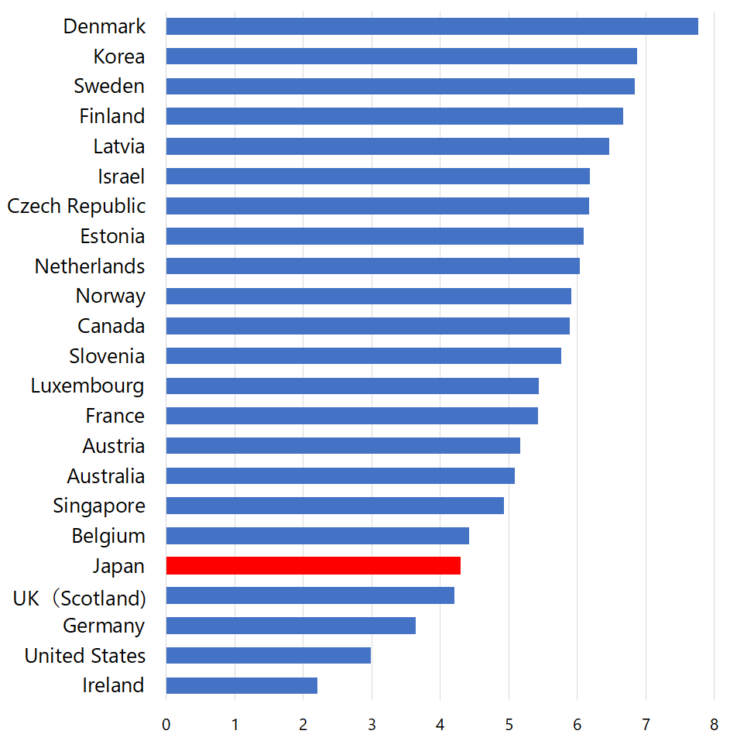
Note: Scores applied based on consideration of eight items such as availability and immediacy of medical data using 10 medical data sets (including inpatients and emergency medical care) and patient surveys. The maximum value is 8.
Source: Formulated by NIRA from Oderkirk, J. (2021), “Survey results: National health data infrastructure and governance”.
Regarding the outlook for the future, Japan’s vaccination status is overwhelmingly lagging behind other developed countries, which may affect future economic recovery (Figure 13). In particular, the recent control of the transmission of the virus in the United Kingdom and the United States is largely due to the rapid spread of vaccines. In the United Kingdom, the formulation of an action plan for the development and securing of vaccines commenced from an early stage in 2020, a speedy approval system has been established, regulations were relaxed in October 2020, and it was decided to flexibly expand the provision of vaccines to individuals other than doctors following education and training. It is significant that many volunteers for the giving of vaccine injections were trained as a result. In addition, people with underlying illnesses were identified from medical record data and urged to be vaccinated, with all vaccination reservations being made electronically.
Figure 13: Status of vaccinations
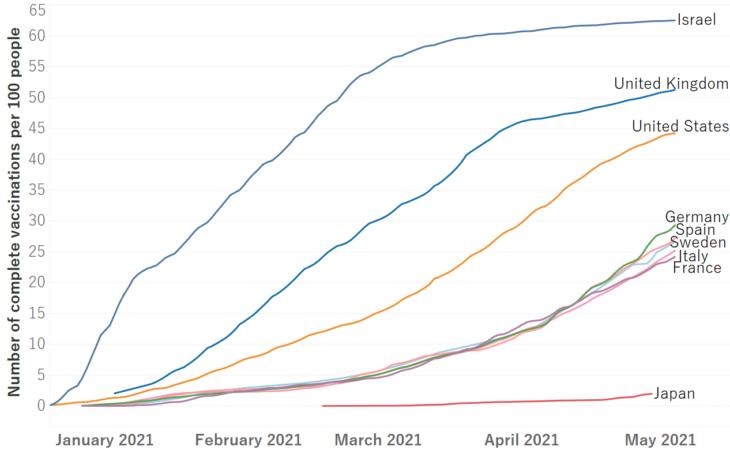
Note: Percentage of people who have been vaccinated at least once.
Source: Formulated by NIRA based on Our World in Data, “Share of people who received at least one dose of COVID-19 vaccine,” which summarizes the published data of the Ministry of Health of each nation, among other sources.
2. Effectiveness of Fiscal Policy
(1) A High Proportion of Policy Lending in Japan’s Fiscal Policy
Throughout the world, nations have been forced to expend significant amounts of funds in order to support medical care and their economies (Figure 14). Looking at figures up to March 2021, it is obvious, despite the low mortality rate of COVID-19 in Japan, that the nation’s COVID-19-related fiscal spending as a percentage of GDP is extremely high internationally. If we look at the breakdown of Japan’s fiscal expenditure, we see that the weight of policy-based lending such as loans for small and medium-sized enterprises, which are in the category of “quasi-fiscal activity,” is outstandingly high against other nations, while fiscal expenditure that directly targets economic growth is not as high.
On the other hand, it is possible that Japan’s future recovery may be as slow as Europe’s. The IMF outlook for April 2021 is also concerning because it suggests that economic recovery may be significantly delayed not only in China but also the United States, which is expected to expend an enormous amount of funds (Figure 15).
Figure 14: Fiscal expenditure in each nation considered
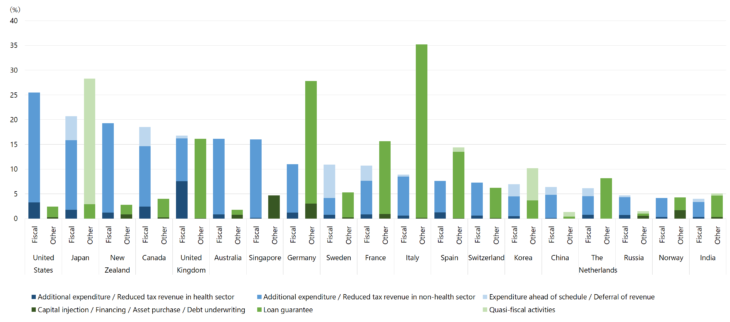
Note: Fiscal measures in response to COVID-19 planned after January 2020 and announced by March 17, 2021. Includes the implementation schedule for 2021. Ratio to GDP (based on World Economic Outlook database: April 2021). Arranged from the left in descending order of number of policies that directly target the economy against GDP.
Source: Formulated by NIRA based on IMF “Database of fiscal policy responses to Covid-19.”
Figure 15: GDP level recovery scenarios (against the previous year) for the US, the UK, Germany, China and Japan (IMF April 2021 outlook)
(2) What is Effective Fiscal Expenditure?
Although Japan’s fiscal expenditure in response to COVID-19 has been quantitatively high by international standards, there may be qualitative issues. The weighting of financing and the provision of guarantees is high in Japan’s fiscal expenditure. Clearly, these measures play a significant role in aiding companies in trouble. However, it will be necessary to verify whether they can effectively support the economy and provide support for the “new normal” during COVID-19 and after COVID-19.
1) Policies to Support Consumption
Japan’s financial expenditures is large-scale, and as mentioned above, the weighting of Fiscal Investment and Loan Program (FILP)- related initiatives is high, such as the provision of financial support by public financial institutions for small and medium-sized enterprises whose management is deteriorating and guarantees of loans from private financial institutions (Figure 14). The greater component of expenditure can be seen to support companies and indirectly support employment. In the component that directly targets economic growth, there has been a high level of support for household and business finances, for example in the form of benefits, and this can be said to have been effective in holding down the unemployment rate and allowing companies to survive. The largest expenditure item in the general account in fiscal 2020 is approximately 13 trillion yen, to fund a “Special Fixed Benefit Payment” of 100,000 yen.
Figure 16: International comparison of consumption expenditure by item
(① Rate of increase / decrease in 2020 2Q-4Q compared to 2019 4Q)
(② Trends in quarterly consumption of durable goods)
Comparing the rate of decrease in personal consumption in 2Q-4Q 2020 / 4Q 2019 by item with Germany, Sweden, the United Kingdom, and the United States, we see that the decline in service consumption explains almost the entirety of the decline in consumption in each nation (Figure 16). In the United Kingdom in particular, service consumption fell sharply, but the proportion of face-to-face services such as dining, tourism, and transportation was high[vii]. In Japan, consumption of durable consumer goods has shown a slight dip, but consumption of durable goods is either positive or displaying no net change in most of the countries surveyed.
Looking at each quarter, consumption of durable goods has picked up from around the third quarter in Germany and the United States. In the case of Germany, it is considered that subsidy policies for eco-friendly vehicles and temporary consumption tax cuts have been successful in increasing consumption. On the other hand, looking at Japanese households, we can confirm that consumption propensity in 2020 was significantly lower than in the previous year, and that the Special Fixed Benefit Payments did not necessarily encourage consumption[viii]. Looking at current household deposit balances, there was an increase of 27 trillion yen from 1007 trillion yen to 1032 trillion yen from December 2019 to September 2020, and it is conjectured that many benefit payments went into savings.
2) Public Investment Towards the Future
Looking at fixed asset formation (Figure 17), major nations are generally sluggish, and Japan’s public-sector figures are almost flat. By contrast, we can see that Germany displays a significant degree of public-sector fixed asset formation in 2Q, which was a difficult period due to COVID-19. Looking at Germany’s budget, as of June the nation decided to focus spending on green-related investment and R&D of AI, quantum computers, 5G, 6G, etc. This type of public capital formation will support GDP in this difficult quarter, contributing 1.42 percentage points.
Figure 17: International comparison of fixed asset formation (quarterly basis from 4Q 2019)
(1) Private sector
(2) Public sector
3) Corporate Metabolism
In the United States, the price of IT-related stocks (GAFA, etc.), for example e-commerce-related and remote work-related stocks, and additionally stocks in companies such as Tesla, is increasing, and even amid the COVID-19 crisis, start-up companies focusing in particular on DX and similar strategies have entered the market one after another from the middle of 2020. Despite COVID-19, Singapore also had a large number of new business openings in 2020, allowing us to point to the functioning of economic dynamism. Comparing the number of new business openings internationally, Japan is not displaying a large number, with a level approximately the same as that of Germany (Figure 18). At the same time, the excess debt of Japanese private-sector companies has ballooned to almost four times the nation’s GDP; in the case of the UK, the figure is slightly less than three times (the next highest among developed nations), indicating that a lack of corporate metabolism is an issue.
Figure 18: Status of new business openings in each nation considered
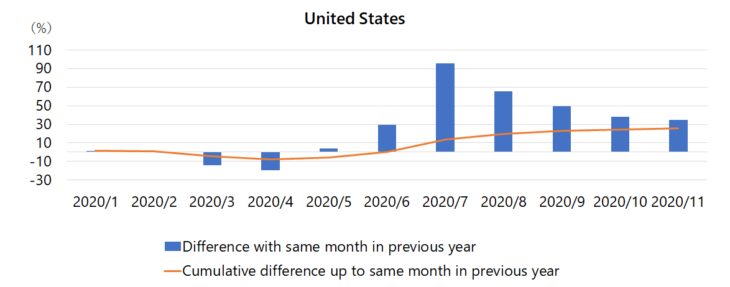
Source: Formulated by NIRA based on Ministry of Justice, “The Statistics on Registration,” German Federal Statistical Office, “Statistics of Business Notifications,” Singapore Department of Statistics, “Formation and Cessation of Business Entities,” and U.S. Census Bureau, “Business Formation Statistics.”
3. Merits and Demerits of Monetary Easing
The governments of each nation considered are increasing bond issuance, and their central banks are purchasing these bonds and maintaining low interest rates. Due in part to this monetary easing, stock prices have remained high, which supports the economy (Figure 19). At the same time, the ratio of outstanding public debt is also increasing in each nation, but Japan’s is the highest, and the structural problems that existed prior to the COVID-19 crisis have worsened. In addition to the challenge of securing financial resources in the future, the expansion of outstanding debt also increases the potential risk to the financial system of “macro-financial imbalance” (Figure 20).
Figure 19: Transition in stock prices
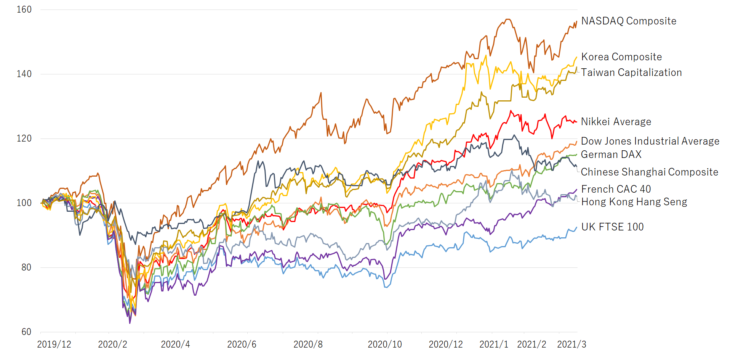
Note: Calculated with the end of December 2019 as 100.
Source: Formulated by NIRA using data based on Thomson Reuters Datastream.
Furthermore, it should be noted with regard to the increase in stock prices, that the rate of return on capital continues to exceed the growth rate, and the disparity between the high-income stratum, who will enjoy the benefits of this, and the poor may be widening worldwide. In particular, it can be seen that in the United States, stock prices such as prices for GAFA stock have risen due to the progress of digitalization, making it possible that the income of the wealthy classes will continue to increase. Globally, disparities are widening depending on whether or not it is possible to digitalize. There are, in particular, many children in developing countries who cannot receive online education, and this is becoming a serious problem.
Figure 20: Trends in the ratio of outstanding national debt to GDP in the US, the UK, Germany, and Japan
Conclusion: Summary of Results of Study and Comments on Certain Policy Challenges
(1) Improvement of Medical Care System, Rapid Response to Vaccination, and Effective Fiscal Expenditure Are Issues
Overall, COVID-19 has had a major impact on all developed nations, but among these nations, in 2020 Japan displayed a low mortality rate and little economic damage, representing a comparatively effective response. However, looking at each, we see that some nations are being flexible in devising responses within their medical care systems, and there are also nations that, given the fact that the economic damage from COVID-19 is concentrated in the area of service consumption, are implementing effective economic measures on this basis.
From an international perspective, it seems that we will gradually see a difference between nations that have effectively invested in the future by means of economic measures, and those that have not. In the case of Japan, it will be essential to fundamentally resolve the issues in the nation’s medical system that are becoming increasingly apparent in 2021. In particular, in order to achieve recovery of the nation’s economy and society and assure economic security, it will be necessary to drastically reform the medical care system (hospital beds, hospitals, etc.), ensure the ability to maneuver in emergencies, provide support for vaccine development and create a system for rapid vaccination. The following two points are the immediate issues that should be discussed.
・Drastic reform of medical care system and fundamental enhancement of speed of vaccination: While the medical care system must unavoidably be reviewed during normal times, in response to a crisis, it is essential to establish systems that enable stronger inter-hospital and inter-regional cooperation resembling Sweden’s. In addition, it will be essential to accelerate the digitalization and online access of medical care. From the perspective of economic security, it will be extremely important to be able to flexibly ease regulations, for example to provide support for research and development of domestically-produced vaccines, shorten the process required until approval, and increase the number of people able to conduct vaccinations.
・Greater ingenuity in fiscal expenditure (wise spending): Although policy modes focusing on employment maintenance and support for leave from work are also necessary, it would be desirable to realize dynamism that promotes reforms looking towards post-COVID business models, such as the provision of support for start-up companies and for DX and greening, as in Germany, and for fiscal expenditure to be balanced with economic revitalization. It will also be necessary to consider effective measures to support consumption rather than simply providing uniform benefits.
(2) What is Important as a Long-term Issue Is to Respond to Increasing Public Debt and Widening Disparities
With regard to response to the expansion of Japan’s public debt, current fiscal expenditure is necessarily extremely high, and the consequent expansion of public debt in tandem with corporate debt will increase macro-financial imbalance, resulting in greater potential risk to the financial system. In addition, interest payments may become a heavy burden in the process of normalizing interest rates. The following two points can be indicated as long-term issues to be discussed.
・ Responding to the expansion of public debt: As disparities widen post-COVID, it will be necessary to examine how to redesign the tax system and to consider long-term fiscal normalization. In the UK, there is a move to raise the corporate tax rate after 2023, when the economy is expected to recover. In the United States, under President Biden, plans to increase corporate tax and taxes on the wealthy are scheduled to be discussed, and the G7 is also moving to discuss the minimum level for corporate tax. It will be necessary for Japan to consider a new tax system for the “new normal” post-COVID.
・Responding to disparities: Looking at the world as a whole, there are concerns about the expansion of debt, the blurring of the boundary between public funds realized through continued monetary easing and financing, and widening disparities (acceleration of the collapse of the middle-class). In the future, it will be necessary for the world as a whole to revive economies by securing financial resources while correcting the widening disparities that have resulted from the COVID-19 crisis. As part of this, we can point to an urgent need to create inclusive safety nets that enable smooth employment transition even if a company goes bankrupt, and to respond to the digital divide. In the area of corporate governance also, it will be necessary for shareholders to further encourage companies to respond to social issues. It should also be borne in mind that while long-term monetary easing has supported the economy by raising stock prices, it has also widened disparities.
References
Hale, Thomas & Angrist, Noam & Goldszmidt, Rafael & Kira, Beatriz & Petherick, Anna Phillips, Toby & Webster, Samuel & Cameron-Blake, Emily & Hallas, Laura & Majumdar, Saptarshi & Tatlow, Helen. (2021). A global panel database of pandemic policies (Oxford COVID-19 Government Response Tracker). Nature Human Behaviour. 5. 10.1038/s41562-021-01079-8.
IMF (2021a) “Fiscal Monitor Database of Country Fiscal Measures in Response to the COVID-19 Pandemic” (https://www.imf.org/en/Topics/imf-and-covid19/Fiscal-Policies-Database-in-Response-to-COVID-19)
―― (2021b) “World Economic Outlook, April 2021: Managing Divergent Recoveries” (https://www.imf.org/en/Publications/WEO/Issues/2021/03/23/world-economic-outlook-april-2021)
OECD (2021) “Business Dynamism during the COVID-19 pandemic: Which Policies for an Inclusive Recovery?” (http://www.oecd.org/coronavirus/policy-responses/business-dynamism-during-the-covid-19-pandemic-which-policies-for-an-inclusive-recovery-f08af011/)
Oderkirk, J. (2021), “Survey results: National health data infrastructure and governance,” OECD Health Working Papers, No. 127, OECD Publishing, Paris, https://doi.org/10.1787/55d24b5d-en. (https://www.oecd.org/sti/survey-results-national-health-data-infrastructure-and-governance-55d24b5d-en.htm)
Office for National Statistics UK (2021a) “International Comparisons of GDP during the coronavirus (COVID-19) pandemic” (https://www.ons.gov.uk/economy/grossdomesticproductgdp/articles/internationalcomparisonsofgdpduring
thecoronaviruscovid19pandemic/2021-02-01)
―― (2020b) “Coronavirus and the latest indicators for the UK economy and society: 11 March 2021” (https://www.ons.gov.uk/peoplepopulationandcommunity/healthandsocialcare/conditionsanddiseases/bulletins/
coronavirustheukeconomyandsocietyfasterindicators/11march2021)
Oxford Martin School University of Oxford “Our World in Data,” (https://ourworldindata.org/)
UK Department of Health and Social Care (2021) “UK COVID-19 vaccines delivery plan” (https://www.gov.uk/government/publications/uk-covid-19-vaccines-delivery-plan)
Japan COVID-19 Countermeasures, ECMOnet, (https://crisis.ecmonet.jp/) (Japanese only)
The Japanese Society of Intensive Care Medicine (2020), “Opinion regarding International Comparison of Beds in ICUs, etc.” (https://www.jsicm.org/news/news200510.html) (Japanese only)
Iwamura, M. (2020), State / Company / Currency: The Inconvenient Future of Globalism, Shincho Sensho (Japanese only)
Ogata, N. (2021), “Effects of Special Fixed Benefit Payments and the Direction for Household Support during the COVID-19 Pandemic,” Japan Research Institute Research Focus, No.2020-036 (Japanese only)
Okina, Y. (2020a) “Why did Sweden choose not to Lock Down ?,” NIRA Opinion Paper No.52
―― (2020b) “What can we learn from Germany’s Response to COVID-19 ?,” NIRA Opinion Paper No.54
Tajika, E. (2020), “How did the Japanese Government confront COVID-19 ?,” The Tokyo Foundation for Policy Research (https://www.tkfd.or.jp/research/detail.php?id=3658) (Japanese only)
Piketty, T. (2014), Capital in the 21st Century, Belknap Press
Reprinted from NIRA OPINION PAPER, No.57 | May 2021*. This article was written in Japanese for NIRA OPINION PAPER and translated by Michael Faul. Discuss Japan reprinted with the permission of the author and NIRA. [August 2021]
*NIRA OPINION PAPER, No.57 | May 2021: https://english.nira.or.jp/papers/opinion_paper/2021/05/characteristics-and-issues-ofjapans-response-to-covid-19.html
[i] Okina (2020a, b)
[ii] It has been pointed out that in addition to a high ratio of face-to-face services, the decline in consumption in the United Kingdom may have statistically inflated the decline in general spending by the government (See References, ONS (UK))
[iii] See Ministry of Health, Labour and Welfare, Health Policy Bureau (2020), “International Comparison of Beds in ICUs, etc.” (Japanese only) (https://www.mhlw.go.jp/content/000664798.pdf)
[iv] See WHO “Private inpatient hospital beds as % of all beds”
[v] “At least avoiding hospital beds being overwhelmed… What is the current situation in Sweden? We ask Dr. Miyagawa Ayako of Karolinska Institute” (Japanese only), The Nikkei (Nihon Keizai Shimbun), December 27, 2020
[vi] See Ministry of Health, Labor and Welfare (2016), “Primary Sources Edition: Overseas Medical Care Systems” (“Survey and Research on the Actual Status of Medical Corporations Overseas”: Report) (Japanese only)
[vii] See ONS (2020)
[viii] See Ogata (2021)
Keywords
- Okina Yuri
- Nippon Institute for Research Advancement
- NIRA
- Japan Research Institute
- COVID-19
- world economy
- medical care
- emergency responses
- economic security
- vaccine development
- public debt
- economic disparities
- tax system
- government finances
